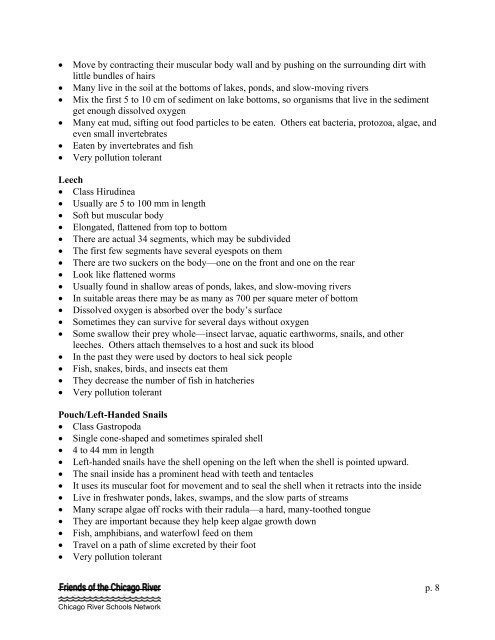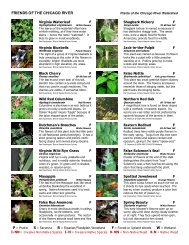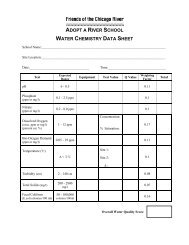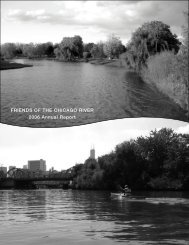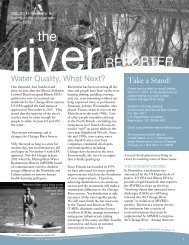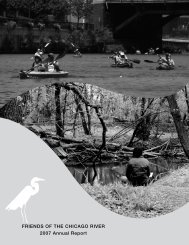Macroinvertebrate Fact Sheet - Friends of the Chicago River
Macroinvertebrate Fact Sheet - Friends of the Chicago River
Macroinvertebrate Fact Sheet - Friends of the Chicago River
You also want an ePaper? Increase the reach of your titles
YUMPU automatically turns print PDFs into web optimized ePapers that Google loves.
• Move by contracting <strong>the</strong>ir muscular body wall and by pushing on <strong>the</strong> surrounding dirt with<br />
little bundles <strong>of</strong> hairs<br />
• Many live in <strong>the</strong> soil at <strong>the</strong> bottoms <strong>of</strong> lakes, ponds, and slow-moving rivers<br />
• Mix <strong>the</strong> first 5 to 10 cm <strong>of</strong> sediment on lake bottoms, so organisms that live in <strong>the</strong> sediment<br />
get enough dissolved oxygen<br />
• Many eat mud, sifting out food particles to be eaten. O<strong>the</strong>rs eat bacteria, protozoa, algae, and<br />
even small invertebrates<br />
• Eaten by invertebrates and fish<br />
• Very pollution tolerant<br />
Leech<br />
• Class Hirudinea<br />
• Usually are 5 to 100 mm in length<br />
• S<strong>of</strong>t but muscular body<br />
• Elongated, flattened from top to bottom<br />
• There are actual 34 segments, which may be subdivided<br />
• The first few segments have several eyespots on <strong>the</strong>m<br />
• There are two suckers on <strong>the</strong> body—one on <strong>the</strong> front and one on <strong>the</strong> rear<br />
• Look like flattened worms<br />
• Usually found in shallow areas <strong>of</strong> ponds, lakes, and slow-moving rivers<br />
• In suitable areas <strong>the</strong>re may be as many as 700 per square meter <strong>of</strong> bottom<br />
• Dissolved oxygen is absorbed over <strong>the</strong> body’s surface<br />
• Sometimes <strong>the</strong>y can survive for several days without oxygen<br />
• Some swallow <strong>the</strong>ir prey whole—insect larvae, aquatic earthworms, snails, and o<strong>the</strong>r<br />
leeches. O<strong>the</strong>rs attach <strong>the</strong>mselves to a host and suck its blood<br />
• In <strong>the</strong> past <strong>the</strong>y were used by doctors to heal sick people<br />
• Fish, snakes, birds, and insects eat <strong>the</strong>m<br />
• They decrease <strong>the</strong> number <strong>of</strong> fish in hatcheries<br />
• Very pollution tolerant<br />
Pouch/Left-Handed Snails<br />
• Class Gastropoda<br />
• Single cone-shaped and sometimes spiraled shell<br />
• 4 to 44 mm in length<br />
• Left-handed snails have <strong>the</strong> shell opening on <strong>the</strong> left when <strong>the</strong> shell is pointed upward.<br />
• The snail inside has a prominent head with teeth and tentacles<br />
• It uses its muscular foot for movement and to seal <strong>the</strong> shell when it retracts into <strong>the</strong> inside<br />
• Live in freshwater ponds, lakes, swamps, and <strong>the</strong> slow parts <strong>of</strong> streams<br />
• Many scrape algae <strong>of</strong>f rocks with <strong>the</strong>ir radula—a hard, many-too<strong>the</strong>d tongue<br />
• They are important because <strong>the</strong>y help keep algae growth down<br />
• Fish, amphibians, and waterfowl feed on <strong>the</strong>m<br />
• Travel on a path <strong>of</strong> slime excreted by <strong>the</strong>ir foot<br />
• Very pollution tolerant<br />
<strong>Chicago</strong> <strong>River</strong> Schools Network<br />
p. 8


